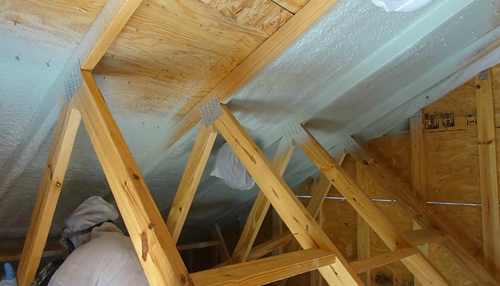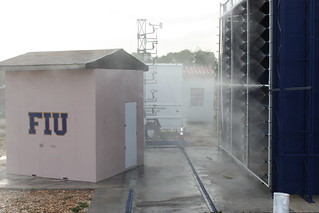Hurricanes are expensive for both home owners and the insurance industry. In 2004 and 2005, eight hurricanes slammed Florida, inflicting $31.3 billion in insured losses. Two Florida Sea Grant research projects are helping to reduce the economic impact of hurricanes on Florida’s vulnerable residential structures valued at $1.5 trillion.

Roof panels treated with spray-applied polyurethane foam adhesives keep out 20 percent more water than untreated panels.
Because much of the hurricane damage to homes comes from leaking roofs, David Prevatt, assistant professor of civil and coastal engineering at the University of Florida, seeks to make roofs more water tight. Prevatt has found that roof panels treated with spray-applied polyurethane foam adhesives keep out 20 percent more water than untreated panels. The spray foam also helps roof sheathing withstand wind uplift significantly more than conventional roof construction.
“Our findings are being used by Florida’s Building Commission to develop new design guidelines for spray foam adhesives in construction,” said Prevatt. “Spray adhesives are a low cost solution to protect older homes and new construction, which could save hundreds of millions of dollars in storm and hurricane related damages along our nation’s coasts.”
While keeping damage at a minimum is essential to lessening a storm’s economic impact, knowing the value of what is at risk and having it properly insured is also an important money saving measure. To asses the value of buildings that could be lost in a hurricane, the insurance industry uses a computer program known as the Florida Public Hurricane Loss Model. However, until Florida Sea Grant researcher Arindam Chowdhury and his team at the Florida International University’s Wall of Wind hurricane testing facility stepped in, the model did not adequately account for interior building damage that results from strong storms and hurricanes.

The Wall of Wind research facility at Florida International University is able to simulate rain water intrusion under strong storm conditions.
“Interior damage, due to rainwater intrusion, accounts for more than 50 percent of total damage,” said Chowdhury. “Through our research at the Wall of Wind, we were able to quantify the total interior damage for low-rise buildings based on the amount of external damage and storm intensity.”
These findings are being used to update Florida’s insurance loss model and have already resulted in the creation of new building codes in Miami-Dade County to strengthen the exterior components of residential structures.
Related Content
David Prevatt presentation “Wind uplift capacity of foam-retrofitted roof sheathing subjected to water leaks.”



